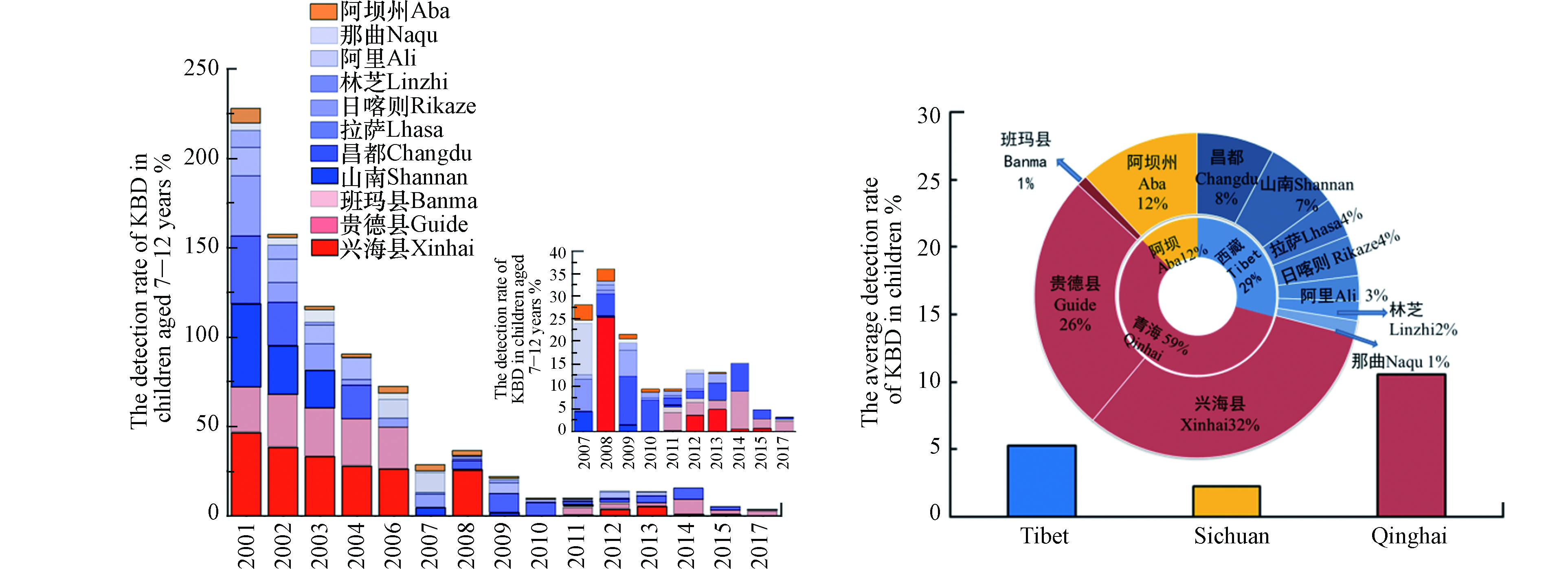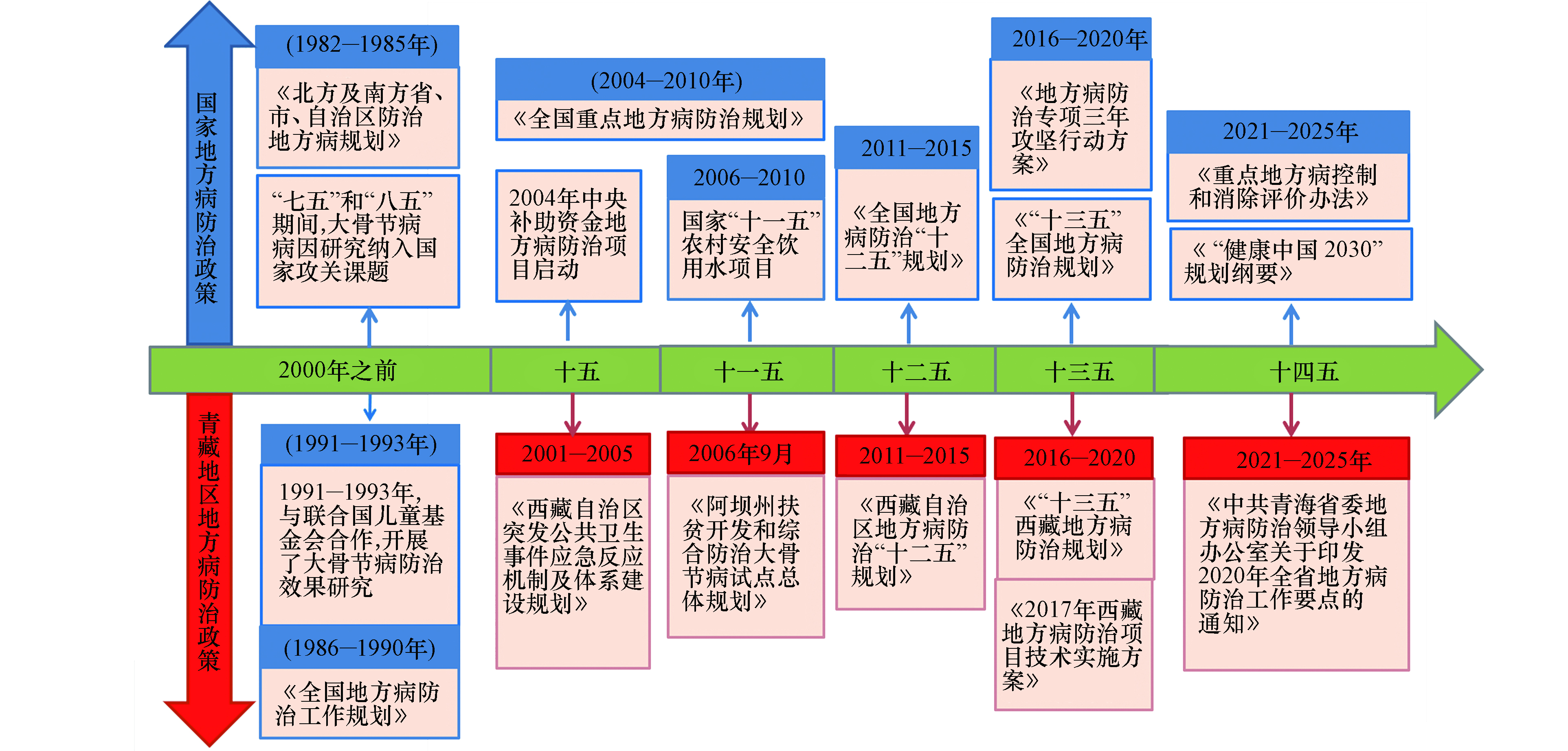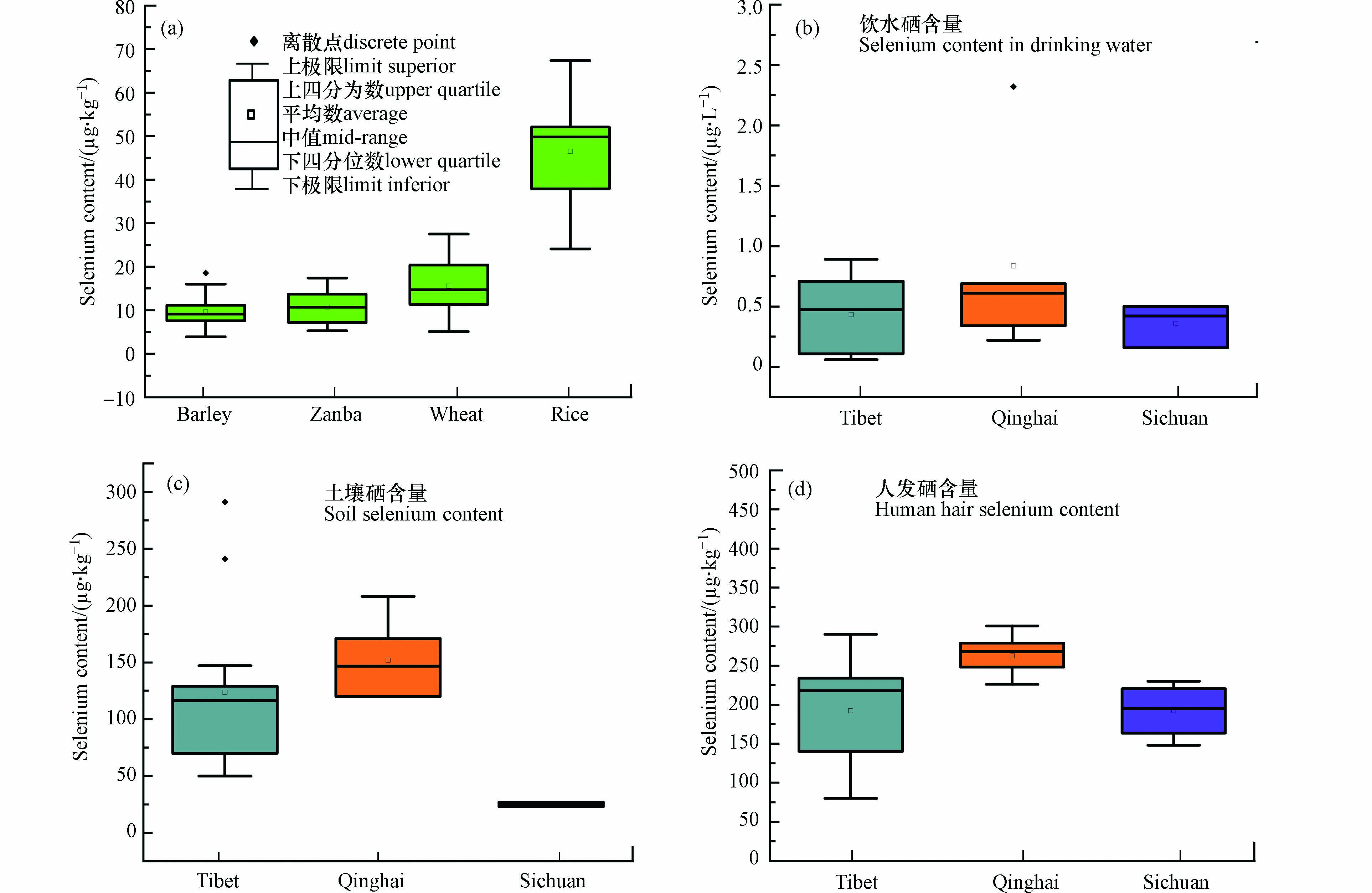-
地方病的发病原因与当地的自然地理环境和居民的传统生活习惯密切相关[1]。二十一世纪初国家对地方病的防治做了陆续明确的规划部署,于2004年10月制定的《全国重点地方病防治规划(2004—2010)》[2],使得大部分地方病得到缓解甚至消除。随着执行的深入,国家陆续发布了《全国地方病防治“十二五”规划》[3]、《“十三五”全国地方病防治规划》[4]以及《地方病防治专项三年攻坚行动方案(2018-2020年)》[5]。这些规划的实施逐步实现了对地方病的控制。目前青藏高原地区主要有大骨节病、饮茶型氟中毒和碘缺乏病等地方病。其中食盐加碘和减少砖茶的使用已被证实为行之有效的防控措施,而大骨节病的精准防控和有效改善仍面临着一定的挑战。
大骨节病是一种变形性、致残性骨关节病,其病理特征是生长板和关节面软骨细胞坏死,导致生长迟缓和继发性骨关节炎[6]。我国卫生健康事业发展统计公报显示,截至2020年底,包括青藏高原在内的379个全国大骨节病病区已实现全部消除[7]。虽然病区控制成效显著,但由于自然地理环境和生活习惯等因素的限制,目前青藏高原地区大骨节病病患现状仍不容乐观,且各地区的病情控制存在不均衡现象。截至2017年青藏高原大部分病区已达消除标准,但在少数地区,如昌都市和青海省部分县区仍存在7—12周岁儿童大骨节病患者[7]。更为重要的是,大骨节病的确切致病原因尚未明确,同时部分重病区防治成果还需进一步巩固。
此外,目前关于大骨节病的研究多集中在单个地区的抽样调查,缺乏全局性的统计分析,而青藏高原地区的大骨节病情数据对于整个中国西部乃至全国均有较大的影响,因此,深入分析青藏高原地区大骨节病的流行趋势和致病因素对于其未来阶段的精准防控与成果巩固具有重要意义。
-
各个年龄阶段均存在大骨节病患者,但儿童和青少年更容易发病[6],因此本文以7—12周岁儿童为研究对象,基于重点区域村落中7—12周岁儿童(常住人口)的临床检查结果,以疑似大骨节病的儿童拍摄双手的X线片结果作为大骨节病发病的科学依据。
研究区域包括青藏高原地区大骨节病病区,分别是:①以川西阿坝州为核心的四川病区;②西藏自治区(包括阿里地区、那曲市、昌都市、日喀则市、林芝、拉萨和山南等7个市区);③青海省的贵德、兴海和班玛县。
-
实现地区的全人类调查需要耗费大量的人力和物力,青藏高原地区从事地方病的医护人员较为匮乏、技术和设备难以支撑开展全面的调查工作,因此需要根据人力、财力等客观条件,制定一个科学合理的抽样调查方法。国家对于大骨节病的监测站点均设立在各区县病情较重的病村,监测对象集中在7—12周岁儿童,每个区县调查人数不少于100名。大骨节病X线检出包括干骼型、干骺骨骺型、骨端型、骨关节型4种手骨病变表现,可合理反映大骨节患病情况[8],因此本文聚焦于X线检出率的大骨节病相关数据。
由于目前青藏高原各区县的大骨节病患病情况数据无法通过官方渠道获得,因此本文通过文献检索、数据摘录的方法对该区域大骨节病的病情监测数据进行检索、筛选和统计分析。Meta分析可明确选择文献标准,能够显著提高文献的综合统计能力,分析结果客观性强,具有科学性和可靠性[9]。本文基于Meta分析方法对所收集的数据进行质量评价与统计分析,研究青藏高原地区7—12周岁儿童大骨节病患病情况的时空变化趋势,分析对应环境和人体中的硒水平含量,全面探究其主要的致病因素。
本文所涉及的数据包括:①青藏高原大骨节病区7—12周岁儿童大骨节X线检出率数据[10-23];②青藏高原大骨节病病区环境和人体硒含量数据[24-39],上述数据来源于2000—2021年发表的有关青藏高原大骨节病病区的相关文献。
-
用Excel和origin软件进行数据分析,将相应的数据合计, 计算算术均数, 使数据量变为最小、又无大的偏离,然后进行省(区)之间的横向比较,说明青藏高原重病区的分布和严重程度。算术平均值不是真正的病情数据,而是历年度该区域病情的理论值,使用这一理论值进行年度间的比较,符合流行病学分析方法[40]。
-
2001—2017年期间青藏高原地区7—12周岁儿童大骨节X线检出率随时间变化趋势如图1所示。从图1可以看出,X线检出率整体呈波动下降趋势。纵观17年间的病情监测数据,以2008年为转折点,青藏高原地区大骨节病病情得到了质的改善,2008年以后,病情一直处于低位波动状态,大部分病区已消除。2017年青藏高原地区大骨节病已基本消除,仅剩日喀则、昌都、阿坝州、贵德、兴海和班玛6个市县区存在零星7—12周岁儿童大骨节病病例,检出率为0.03%—2.27%。这主要是因为国家实施换粮、补硒、改水、异地搬迁和退耕还林等有效防治措施使大骨节病得到了缓解。此外,居民生活水平日益提高,食物来源多样,营养均衡,儿童的免疫能力提高,使大骨节病得到了有效的防控[41-42]。此外,对比各地区17年间检出率的平均值可以看出,青海7—12周岁儿童大骨节病平均检出率最高,为10.6%,占平均总检出率的59%;其次是西藏,平均检出率为5.3%,占平均总检出率的29%;四川省阿坝州平均检出率最低,为2.2%,占平均总检出率的12%;其中青海地区的兴海县和贵德县的平均检出比例较高,分别占32%和26%;西藏自治区的昌都市和山南市平均检出率情况也不容忽视,分别占比8%和7%。上述结果表明青藏高原地区大骨节病虽然得到了有效的控制,但各省份及相关地市的消除速率并不完全一致,这可能与各地市自然地理环境的差异,以及防控程度和经济发展的不均衡有关[43]。
基于国家五年规划时间划分,将2001—2017年分割为4个时间段,分别计算每个时间段各地区X线检出率的算术平均值,归一化处理后进行空间尺度的对比研究,其空间趋势分布结果如图2所示。如图2a所示,在2001—2005年国家第10个五年规划期间,阿里地区的检出率数据缺失,相对检出率较高的地区是兴海、山南、昌都、贵德和拉萨,分别占总检出比例的21.5%、19.8%、16.9%、15.1%和9.9%。其次是日喀则、林芝、那曲和阿坝州,分别占总检出比例的8.1%、3.9%、2.4%和2.4%。2006—2010年属于国家第十一个五年规划(图2b),此期间检出率较高的地区是兴海、贵德、阿里和昌都,分别占总检出比例的34.3%、31%、9.9%和9.6%。兴海、贵德和昌都依旧是大骨节病高发区,而山南和拉萨的大骨节病情得到了快速的控制和消除,检出率占比分别从19.8%和9.9%降低到2.1%和3.6%。日喀则、林芝和那曲的检出率也有所下降。2011—2015年国家第十二个五年规划期间(图2c),那曲和林芝大骨节病已达到消除标准,贵德、昌都、兴海和日喀则仍存在儿童大骨节病病例,检出率分别占总检出比例的32.9%、26.2%、17.5%和11.7%,阿里地区的检出率占比已降低到1.7%。2016—2017年属于国家第十三个五年规划的前两年,结合图2d和图1数据结果可以看出,7—12周岁儿童大骨节病得到有效控制,只存在零星患者集中在贵德、班玛、昌都、日喀则和阿坝州,其他各市区均已达到消除标准。
通过年度和区域之间的比较分析可以看出,大骨节病的控制成效较为显著,这与国家相关政策的制定与实施息息相关。如图3国家政策条例所示,1981年到2000年期间,将大骨节病病因研究纳入国家攻关课题,并开展国际合作与交流,使大骨节病得到重视和控制。“十五”期间,国家增拨防治专款,地方政府也开始大力加强疾病预防控制工作。“十一五”期间,全国制定了一系列的防治措施,包括换粮、补硒、改水、易地搬迁等政策,此期间大骨节病的控制成效较为显著。“十二五”期间,中央投入9.29亿元开展地方病监测工作,改善地方病病区生态环境,取得了重要的成效[3]。 “十三五”期间逐步开展地方病消除和控制工作 [4],国家从卫生、扶贫、林业、教育等全方面制定了一系列政策,致力于大骨节病的防控与消除 [4]。
从十五开始地方政府加大对大骨节病的防控力度,在全国政策的指引下,制定了适合各自地区发展现状与需求的详细方案。如图3地方政策条例所示,十五期间西藏自治区人民政府制定并实施了《西藏自治区突发公共卫生事件应急反应机制及体系建设规划》;十一五期间阿坝州制定了《阿坝州扶贫开发和综合防治大骨节病试点总体规划》;十二五期间西藏自治区地方政府每年拨出180万元用于大骨节病治疗工作 [3];在2017年西藏自治区制定《西藏地方病防治项目技术实施方案》,并且在《“十三五”全国地方病防治规划》政策的引导下制定了《西藏自治区地方病防治“十三五”规划》。这些规划的实施逐步实现了对大骨节病的精准防治。综上所述,2001—2017年期间,随着换粮、补硒、改水、易地搬迁和退耕还林还草等防控措施的实施,大骨节病情基本得到了控制。十三五期间,青藏高原地区实现了大骨节病100%的控制,但还未达到100%消除标准,在贵德、班玛、兴海、边坝、洛隆、八宿、左贡、芒康等区县仍存在现症大骨节病患者,而我国目前仍有17.8万现症大骨节病患者[4]。因此接下来有必要针对重病区县进行大骨节病情的实时监测以及相关致病因素的深入研究。
-
自发现大骨节病以来,相关学者对其病因做了大量研究工作,目前提出的主要病因包括:环境缺硒、饮水有机物中毒、粮食真菌毒素中毒等。虽然众多研究表明上述因素与大骨节病发病率有一定的相关性,但是目前对于确切的致病因素尚没有统一的定论,多因素的综合作用也可能导致发病。
-
大量调查研究表明,大骨节病地区土壤、粮食、饮用水体等外环境和人体内环境的硒浓度水平均低于非病区 [33]。而硒对人体健康具有重要的作用,硒可以减缓体内过氧化反应从而提高人体免疫力,有利于维持软骨的正常代谢[44-46]。国家为了提高大骨节病区环境硒水平,先后开展换粮、补硒、改水和易地搬迁等综合防控措施,特别是针对学龄儿童实施“教育三包”等政策,这些政策的实施保障了病区居民的营养健康与安全[33]。本文对青藏高原典型患病区2000年以后外界环境和人体内硒的含量、分布状况和内在联系进行了探究,结果如图4所示。其中图4a为青藏高原地区粮食硒含量分布图。由于各地的粮食硒的相关数据有限,本文中以整个青藏高原区域粮食硒为研究对象,其中大米为外购粮食作物,硒含量最高,为46.5 μg·kg−1,小麦、糌粑和青稞均为本地作物,硒含量均低于大米,分别为15.5、10.7、9.7 μg·kg−1。除了外源大米外,其余粮食硒含量均低于国家标准粮食硒的健康值(25 μg·kg−1)[34]。图4b、4c和4d分别为西藏自治区、青海和四川地区饮水、土壤和头发组织中的硒含量分布。其中饮水中的硒含量分布情况显示,四川地区饮水硒含量的平均浓度最高,为0.84 μg·L−1,西藏次之,为0.43 μg·L−1,青海最低,为0.36 μg·L−1。3个地区的土壤硒含量平均浓度分布与饮水类似(图4c),四川地区硒含量仍处于最高水平,为152 μg·kg−1,西藏次之,为123.6 μg·kg−1,青海最低,为25 μg·kg−1。此外,青藏高原地区土壤硒的平均浓度均低于国家土壤硒含量标准(175 μg·kg−1)[34],青海地区尤为严重。图4d为3个地区人体头发组织中的硒含量分布特征,与饮用水和土壤中的分布情况类似,四川地区人体头发硒含量平均浓度最高,为262.5 μg·kg−1,已基本脱离缺硒状态 (<200 μg·kg−1)[34]。相比而言,西藏和青海地区人体头发组织硒含量水平仍处于较低水平,分别为192.2 μg·kg−1和192 μg·kg−1。但和1987—1990年间缺硒地区人群发硒含量(139 μg·kg−1)相比[34],青藏高原地区人体硒含量有明显升高的趋势。
以上结果表明,大骨节病病区粮食、土壤和饮水仍处于低硒状态,3个地区人体组织中的硒含量分布趋势与各地区饮水和土壤介质中硒浓度水平分布趋势基本一致,在四川最高、西藏次之、青海最低。与四川地区相比,西藏自治区和青海地区的粮食作物、饮水、土壤和人体头发组织中的平均硒含量均处于较低水平。随着青藏高原地区社会经济条件的改善,政府的换粮、补硒、改水等防控措施的实施,外购大米增加了外源性硒的输入,这在很大程度上提高了人体中硒水平含量。值得注意的是,四川地区人体虽已基本脱离低硒状态,但仍有大骨节病患者存在,因此除了缺硒外,大骨节病还可能与其他因素有关。
-
水环境中广泛存在有机污染物,这些污染物通常具有脂溶性,能够进入人体并可能对生殖与内分泌等系统造成不利影响,同时也可能导致大骨节病的发生[47]。王金达等[48]的研究表明在中国典型大骨节病地区居民饮用水中腐殖酸的含量为0.69—1.16 mg·L−1,高于相应地带非病区居民饮用水的腐殖酸含量(0.34—0.37 mg·L−1),饮水中腐殖酸被认为是一项致病因素。此外,多个研究表明病区腐殖酸含量与硒含量存在明显的线性负相关关系,低硒、高腐殖酸是大骨节病区的环境特征[49-50]。An等[51]从细胞实验和动物实验两方面研究了黄腐酸对机体的损伤机制,发现黄腐酸中的氧或羟基官能团会干扰细胞膜产生包含醌类、酚类、羰基、羟基、羧基在内的自由基,这些稳定自由基具有高浓度和高反应性,可能会对软骨细胞造成损伤。Liang等[52]通过动物实验发现,人工合成腐殖酸可通过引起家兔软骨细胞过氧化反应导致软骨细胞损伤。Ioannidis等[53]通过动物实验发现,黄腐酸使软骨细胞产生H2O2的能力增加,这些H2O2不会破坏细胞膜,但它们能够诱导软骨细胞胶原分泌的增强,进而导致大骨节病的发生。
-
大量研究表明粮食中的真菌毒素是大骨节病的致病因子[54-59]。安康等[55]通过动物实验证明脱氧雪腐镰刀菌烯醇(DON)毒素可致软骨损伤,还可导致干骺早闭,胶原破坏,最终表现为骨关节炎。杨建伯[57]提出T-2毒素是大骨节病的致病因子。Sun等[60]通过检测青海省大骨节病村和非大骨节病村粮食中T-2毒素发现,3个大骨节病村小麦和面粉中T-2毒素污染水平分别为78.91 ng·g−1和47.47 ng·g−1,显著高于非大骨节村样品T-2毒素含量(12.23 ng·g-1)。但杨进生、张矢远等[61]在大骨节病人血中未检出T-2毒素,因此T-2毒素作为粮食中的真菌毒素是否损害软骨细胞还需要进一步的实证研究。目前大量的研究主要聚焦于DON毒素和T-2毒素,而粮食中真菌毒素除了上述两种毒素外,还包括串珠镰刀菌素(MON)和NIV毒素[50]等,因此采取什么样的流行病学方法研究二者之间的相关性以及明确是哪一种真菌毒素与大骨节病发病率更为相关是今后的研究重点。
-
除了上述3种研究较多的致病因素外,很多研究表明在低硒条件下的大骨节病区,人类微小病毒HPVB19的毒力会增强,从而也可能导致大骨节病的发生[45-47]。王治伦等[62]检测了大骨节病区和非病区儿童血清中的HPVB19,发现病区儿童更容易感染HPVB19。Elbadry等[63]的研究也进一步证明人类微小病毒HPVB19会导致短暂骨髓衰竭综合征等多种病症。此外,高海拔、寒冷气候与大骨节的严重程度之间也具有一定的关系[64]。Okumiya等[65]研究表明高原的高海拔、低气压、强辐射、缺氧环境等能够迫使人体体内的过氧化反应,体内氧自由基增加影响人体正常新陈代谢,进而导致疾病的发生[65-66]。大骨节病的发病机理与上述几种致病因素都可能存在一定的相关性,然而其具体的致病因素还需要进一步研究。
基于对大骨节病致病因素的分析,本文总结了可能的致病因素,如图5所示。对于大骨节病来说,环境缺硒是目前较为认可的致病因素之一。此外,粮食中的真菌毒素和饮水中的腐殖质能够损害软骨细胞,也可导致大骨节病的发生,但是具体是哪一种粮食真菌毒素还需要进一步的深入研究。此外,除了上述致病因素外,一些文献表明在低硒环境下,人类微小病毒HPVB19的毒力在一定程度上会增强,进而导致大骨节病的发生。高原特殊环境导致的体内氧自由基增多也是潜在的致病因素。从目前的研究来看,虽然很多学者在大骨节病的致病机理方面做了大量工作,但是仍不能准确地解释其发病机理,因此,大骨节病具体的致病因素还需要进一步的深入研究。
-
本文研究了青藏高原地区7—12周岁儿童大骨节病的流行趋势及致病因素。2001—2017年间,随着国家五年规划的实施,地方政府也开始制定了系列适合各自地区发展现状与需求的详细方案,使得儿童大骨节X线检出率整体呈波动下降趋势。2017年青藏高原地区大骨节病已基本消除,仅剩昌都、日喀则、阿坝州、贵德、兴海和班玛6个市县区存在零星儿童大骨节病患者,检出率降低到0.03%—2.27%。17年间,青海7—12周岁儿童大骨节病平均检出率最高,为10.6%,占平均总检出率的59%;其次是西藏,平均检出率为5.3%,占平均总检出率的29%;阿坝州平均检出率最低,为2.2%,占平均总检出率的12%;其中青海省的兴海县和贵德县平均检出率占比最高,分别为32%和26%;西藏自治区的昌都市和山南市平均检出率占比分别为8%和7%,也应引起重视。目前大骨节病的监测工作仍存在一些问题需要解决:大骨节病患病情况数据无法通过官方渠道获得,有的区县目前监测点的病情不能代表整个区域的实际病情,建议根据实际情况增加或更换监测点,使监测数据能够真正反映该区域的实际病情。
对青藏高原大骨节流行区的环境和人体硒分布水平进行统计分析,发现大骨节病区的水、土、粮以及人群均处于低硒状态,环境缺硒是导致大骨节病发生的重要因素,但并不是唯一因素。粮食中的真菌毒素、饮水中腐殖质的种类和含量、低硒环境下毒性增强的人类微小病毒HPVB19,以及高原的低气压、高辐射、缺氧的环境特征也会导致大骨节病的发生。因此,大骨节病可能是多因素综合作用导致的疾病,致病因素还需进一步深入研究。
青藏高原地区大骨节病的流行特征及致病因素探究
Epidemiological trend and pathogenic factors of KBD in Qinghai-Tibet Plateau region
-
摘要: 本文系统分析了青藏高原地区2001—2017年间大骨节病的时空流行特征,研究结果显示,青藏高原地区7—12周岁儿童大骨节病X线检出率整体下降趋势显著,随着换粮、补硒、改水、易地搬迁和退耕还林还草等防控措施的实施,大骨节病基本得到了控制。以2008年为转折点,大骨节病得到了质的改善,2017年大部分病区县已基本消除。青海省7—12周岁儿童大骨节病平均检出率最高,为10.6%,占平均总检出率的59%;其次是西藏自治区和阿坝州,平均检出率分别为5.3%和2.2%,占平均总检出率的29%和12%。其中,青海的兴海县和贵德县以及西藏的昌都市和山南市平均检出率占比较高,分别为32%、26%、8%和7%,应当引起重视。本文根据国内外相关研究,总结分析了大骨节病主要致病因素的研究进展,其中缺硒是重要因素之一,此外,粮食霉菌、饮水中过量的腐殖酸、强辐射和缺氧环境也会增加大骨节病的患病风险。目前青藏高原地区大部分病区依旧处于低硒环境,补硒换粮仍是最有效的控制手段,但是具体的致病因素还需要进一步的深入探究。本研究可为青藏高原地区大骨节病的防治提供参考和理论依据。Abstract: This paper systematically analyzed the temporal and spatial epidemiological characteristics of Kashin-Beck disease (KBD) in the Qinghai-Tibet Plateau from 2001 to 2017. The results showed that the Kashin-Beck X-ray detection rate of children aged 7 to 12 in the Qinghai-Tibet plateau area decline significantly. With the implementation of the prevention and control measures such as grain exchange, selenium supplementation, water improvement, relocation and returning farmland to forest and grassland, KBD has been basically under control. Transfer point in 2008, the prevalence of KBD has decreased significantly, and most affected areas and counties were eliminated in 2017. The mean detection rate of KBD in children aged 7—12 in Qinghai province was the highest with 10.6%, accounting for 59% of the total mean detection rate. Tibet Autonomous Region and Aba Prefecture had an average detection rate of 5.3% and 2.2%, respectively, comparing to 29% and 12% of the total average detection rate. In particular, Xinghai and Guide in Qinghai and Changdu and Shannan in Tibet make up higher average detection rates with 32%, 26%, 8%, and 7%, respectively, which should be taken seriously. The main pathogenic factors of KBD were summarized and analyzed based on relevant studies. Notably, selenium deficiency is the one of important factors. In addition, food mold, excessive humic acid in drinking water, intense radiation and the anoxic environment also increase the risk of KBD. At present, most of the disease areas in the Qinghai-Tibet Plateau are still in a low selenium environment, indicating that selenium supplement for food is still the most effective control method. However, the specific pathogenic factors need to be further evaluated. This study can further promote the relevant research and devote efforts to the prevention and treatment of KBD in the Qinghai-Tibet Plateau.
-
Key words:
- Qinghai-Tibet Plateau /
- Kashin-Beck disease /
- fashion trends /
- pathogenic factors
-

-
-
[1] 孙殿军, 高彦辉, 刘辉. 中国地方病的有效控制乃至消除得益于优越的社会主义制度 [J]. 中华疾病控制杂志, 2019, 23(7): 745-748,753. SUN D J, GAO Y H, LIU H. Effective control and even elimination of endemic diseases in China benefits from the superior socialist system [J]. Chinese Journal of Disease Control & Prevention, 2019, 23(7): 745-748,753(in Chinese).
[2] 中华人民共和国卫生部. 卫生部办公厅关于《全国重点地方病防治规划(2004-2010年)》终期执行情况的通报[EB/OL]. [2004-10-14]. http://www.gov.cn/gongbao/content/2004/content_63045.htm ,2004-10-14. Ministry of Health, PRC. Circular of the General Office of the Ministry of Health on the final Implementation of the National Plan for The Prevention and Control of Key Endemic Diseases (2004-2010) [EB/OL]. [2004-10-14].http://www.gov.cn/gongbao/content/2004/content_63045.htm,2004-10-14.
[3] 郭敏, 尼玛仓决, 赵生成, 等. 西藏自治区地方病防治“十二五”规划终期评估报告 [J]. 中国地方病防治杂志, 2016, 31(12): 1333-1334,1337. GUO M, NI M, ZHAO S C, et al. Evaluation report of the 12th Five-Year Plan for endemic disease control in Tibet autonomous Region [J]. Chinese Journal of Control of Endemic Diseases, 2016, 31(12): 1333-1334,1337(in Chinese).
[4] 中华人民共和国国家卫生和计划生育委员会. 《“十三五”全国地方病防治规划》[EB/OL]. [2017-03-16]. http://www.nhc.gov.cn/jkj/s5873/201703/67e87178addf4957b13d83f55583927d.shtml,2017-03-16. National Health and Family Planning Commission of the People's Republic of China. National Endemic Disease Prevention and Control Plan during the 13th Five-Year Plan Period [EB/OL]. [2017-03-16].http://www.nhc.gov.cn/jkj/s5873/201703/67e87178addf4957b13d83f55583927d.shtml,2017-03-16.
[5] 高彦辉. 地方病防治专项三年攻坚行动方案(2018—2020年)工作任务解读 [J]. 中华地方病学杂志, 2019, 38(1): 1-3. doi: 10.3760/cma.j.issn.2095-4255.2019.01.001 GAO Y H. Interpretation of the tasks of the special three-year program for prevention and control of endemic diseases (2018-2020) [J]. Chinese Journal of Local Epidemiology, 2019, 38(1): 1-3(in Chinese). doi: 10.3760/cma.j.issn.2095-4255.2019.01.001
[6] GUO X, ZHANG F, WANG X, et al. Kashin-beck disease (KBD)[M]//Endemic Disease in China. Singapore: Springer Singapore, 2019: 125-173. [7] 中国政府网, 规划发展与信息化司. 《2020年我国卫生健康事业发展统计公报》[EB/OL]. [2021-07-13]. http://www.nhc.gov.cn/guihuaxxs/s10743/202107/af8a9c98453c4d9593e07895ae0493c8.shtml,2021-07-13. Department of Planning, Development and Information Technology, Gov. cn. Statistical Bulletin on the Development of China's Health Undertakings in 2020 [EB/OL]. [2021-07-13]. http://www.nhc.gov.cn/guihuaxxs/s10743/202107/af8a9c98453c4d9593e07895ae0493c8.shtml, 2021-07-13.
[8] 彭少麟, 郑凤英. Meta分析及MetaWin软件 [J]. 土壤与环境, 1999, 8(4): 295-299. PENG S L, ZHENG F Y. Introduction of MetaWin software [J]. Soil and Environmental Sciences, 1999, 8(4): 295-299(in Chinese).
[9] 赵光辉, 王东峰, 惠曙国, 等. 成人大骨节病与骨性关节炎患者膝关节影像学参数比较 [J]. 中国骨与关节损伤杂志, 2021, 36(4): 402-404. doi: 10.7531/j.issn.1672-9935.2021.04.023 ZHAO G H, WANG D F, HUI S G, et al. Comparison of imaging parameters of knee joint in adult patients with KBD and osteoarthritis [J]. Chinese Journal of Bone and Joint Injury, 2021, 36(4): 402-404(in Chinese). doi: 10.7531/j.issn.1672-9935.2021.04.023
[10] 全国大骨节病病情监测组. 2001年全国大骨节病病情监测 [J]. 中国地方病学杂志, 2002, 21(5): 34-36. National Kashin - Beck Disease Monitoring Group. 2001 National Kashin-beck disease surveillance summary report [J]. Chinese Journal of Local Epidemiology, 2002, 21(5): 34-36(in Chinese).
[11] 李群伟, 杨建伯. 2002年全国大骨节病病情监测总结报告 [J]. 中国地方病学杂志, 2002, 21(5): 670-672. National Kashin - Beck Disease Monitoring Group. LI Q W, YANG J B. The monitoring report of Kashin-Beck disease prevalence rate of whole country in 2002 year [J]. Chinese Jouranl of Endemiology, 2002, 21(5): 670-672(in Chinese).
[12] 全国大骨节病病情监测组. 2003年全国大骨节病病情监测总结报告 [J]. 中国地方病学杂志, 2004, 23(2): 670-672. National Kashin - Beck Disease Monitoring Group. Institute for KaschinBeck Disease Control, Harbin Medical University, Harbin, China}. The monitoring report of Kaschin-Beck disease prevalence rate of the whole country in 2003 [J]. Chinese Journal of Endemiology, 2004, 23(2): 670-672(in Chinese).
[13] 全国大骨节病病情监测组. 2004年全国大骨节病病情监测总结报告 [J]. 中国地方病学杂志, 2005, 24(6): 634-636. National Kashin - Beck Disease Monitoring Group. Report of national surveillance on Kaschin-Beck disease prevalence in 2004 [J]. Chinese Journal of Endemiology, 2005, 24(6): 634-636(in Chinese).
[14] 全国大骨节病监测组, 刘宁. 2005年全国大骨节病病情监测总结报告 [J]. 中国地方病学杂志, 2006, 25(6): 670-672. National Kashin - Beck Disease Monitoring Group. Report of a national survey of Kaschin-Beck disease prevalence in 2005 [J]. Chinese Journal of Endemiology, 2006, 25(6): 670-672(in Chinese).
[15] 全国大骨节病监测组, 刘宁. 2006年全国大骨节病病情监测总结报告 [J]. 中国地方病学杂志, 2007, 26(6): 646-648. National Kashin - Beck Disease Monitoring Group. Report of a national survey of Kaschin-Beck disease prevalence in 2006 [J]. Chinese Journal of Endemiology, 2007, 26(6): 646-648(in Chinese).
[16] 李强, 赵志军, 周珉, 等. 2007年青海省大骨节病病情监测报告 [J]. 中华地方病学杂志, 2008, 27(3): 292. doi: 10.3760/cma.j.issn.1000-4955.2008.03.037 LI Q, ZHAO Z J, ZHOU M, et al. Surveillance report of Kashin-beck disease in Qinghai province in 2007 [J]. Chinese Journal of Local Epidemiology, 2008, 27(3): 292(in Chinese). doi: 10.3760/cma.j.issn.1000-4955.2008.03.037
[17] 刘辉, 周令望, 刘运起. 2000—2007年全国大骨节病病情监测结果分析 [J]. 中国地方病学杂志, 2009, 28(5): 554-556. LIU H, ZHOU L W, LIU Y Q. Analysis of surveillance results of Kashin-beck disease in China from 2000 to 2007 [J]. Chinese Journal of Local Epidemiology, 2009, 28(5): 554-556(in Chinese).
[18] 李强, 赵志军, 白生录, 等. 2009年青海省大骨节病病情监测报告 [J]. 中华地方病学杂志, 2011, 30(5): 579. doi: 10.3760/cma.j.issn.1000-4955.2011.05.032 LI Q, ZHAO Z J, BAI S L, et al. Surveillance report of Kashin-beck disease in Qinghai province in 2009 [J]. Chinese Journal of Local Epidemiology, 2011, 30(5): 579(in Chinese). doi: 10.3760/cma.j.issn.1000-4955.2011.05.032
[19] 龚弘强, 赵生成, 尼玛仓决, 等. 2014年西藏昌都地区大骨节病病情监测报告 [J]. 国外医学(医学地理分册), 2015, 36(4): 270-273. GONG H Q, ZHAO S C, NI M, et al. Monitoring report of kashin-beck disease in Changdu region of Tibet in 2014 [J]. Foreign Medical Sciences (Section of Medgeography), 2015, 36(4): 270-273(in Chinese).
[20] 李强, 赵志军, 曹有平, 等. 2012年青海省大骨节病病情监测报告 [J]. 中华地方病学杂志, 2015, 34(4): 308. doi: 10.3760/cma.j.issn.2095-4255.2015.04.022 LI Q, ZHO Z J, CAO Y P. Surveillance report of Kashin-beck disease in Qinghai province in 2012 [J]. Chinese Journal of Local Epidemiology, 2015, 34(4): 308(in Chinese). doi: 10.3760/cma.j.issn.2095-4255.2015.04.022
[21] 李强, 赵志军, 曹有平, 等. 2010年青海省大骨节病病情监测报告 [J]. 中华地方病学杂志, 2016, 35(7): 530. doi: 10.3760/cma.j.issn.2095-4255.2016.07.014 LI Q, ZHOU X, ZHAO Z J, et al. Surveillance report of Kashin-beck disease in Qinghai province in 2010 [J]. Chinese Journal of Local Epidemiology, 2016, 35(7): 530(in Chinese). doi: 10.3760/cma.j.issn.2095-4255.2016.07.014
[22] 赵生成, 龚弘强, 郭敏, 等. 2015年西藏大骨节病病情监测报告 [J]. 医学动物防制, 2016, 32(11): 1289-1290. doi: 10.7629/yxdwfz201611038 ZHAO S C, GONG H Q, GUO M, et al. Surveillance report of Kashin-beck disease in Tibet in 2015 [J]. Journal of Medical Pest Control, 2016, 32(11): 1289-1290(in Chinese). doi: 10.7629/yxdwfz201611038
[23] 张强, 姜泓, 马静, 等. 2017年青海贵德兴海班玛儿童大骨节病病情监测报告 [J]. 中国地方病防治杂志, 2017, 32(12): 1335. ZHANG Q, JIANG H, MA J, et al. Surveillance report of Kashin-beck disease in Bama children in Xinghai, Guizhou Province in 2017 [J]. Chinese Journal of Control of Endemic Diseases, 2017, 32(12): 1335(in Chinese).
[24] TIAN Y, ZHA X J, GAO X, et al. Spatial analysis and biogeochemical cycles: A comparative study of kashin-beck disease villages and non-disease villages in Linzhou County, Tibet [J]. Journal of Resources and Ecology, 2020, 11(2): 232-246. doi: 10.5814/j.issn.1674-764x.2020.02.011 [25] 张强, 丁萍, 安永清, 等. 2005年和2006年青海省部分地区居民生活饮用水氟、砷、硒含量分析 [J]. 青海医药杂志, 2009, 39(2): 63-66. ZHANG Q, DING P, AN Y Q, et al. Analysis of fluorine, arsenic and selenium contents in drinking water of residents in some areas of Qinghai Province in 2005 and 2006 [J]. Qinghai Medical Journal, 2009, 39(2): 63-66(in Chinese).
[26] GUO Y N, LI H R, YANG L S, et al. Trace element levels in scalp hair of school children in Shigatse, Tibet, an endemic area for kaschin-beck disease (KBD) [J]. Biological Trace Element Research, 2017, 180(1): 15-22. doi: 10.1007/s12011-017-0988-0 [27] WANG J, LI H R, YANG L S, et al. Distribution and translocation of selenium from soil to highland barley in the Tibetan Plateau Kashin-Beck disease area [J]. Environmental Geochemistry and Health, 2017, 39(1): 221-229. doi: 10.1007/s10653-016-9823-3 [28] LEI R H, JIANG N, ZHANG Q, et al. Prevalence of selenium, T-2 toxin, and deoxynivalenol in kashin-beck disease areas in Qinghai Province, northwest China [J]. Biological Trace Element Research, 2016, 171(1): 34-40. doi: 10.1007/s12011-015-0495-0 [29] ZHA X J, GAO X. Ecological analysis of Kashin-Beck osteoarthropathy risk factors in Tibet's Qamdo City, China [J]. Scientific Reports, 2019, 9(1): 1-8. [30] CHEN Z, LI H R, YANG L S, et al. Hair selenium levels of school children in kashin-beck disease endemic areas in Tibet, China [J]. Biological Trace Element Research, 2015, 168(1): 25-32. doi: 10.1007/s12011-015-0333-4 [31] ZHANG B J, YANG L S, WANG W Y, et al. Environmental selenium in the Kaschin-Beck disease area, Tibetan Plateau, China [J]. Environmental Geochemistry and Health, 2011, 33(5): 495-501. doi: 10.1007/s10653-010-9366-y [32] 何锦, 安永会, 贾小丰, 等. 阿坝州饮水中硒和氟元素与大骨节病关系研究 [J]. 地下水, 2012, 34(2): 9-10. doi: 10.3969/j.issn.1004-1184.2012.02.04t HE J, AN Y H, JIA X F, et al. Study on relationship between selenium and fluoride concentrations in drinking water and kaschin-beck disease in aba's kaschin-beck disease areas [J]. Ground Water, 2012, 34(2): 9-10(in Chinese). doi: 10.3969/j.issn.1004-1184.2012.02.04t
[33] 王婧, 李海蓉, 杨林生, 等. 西藏昌都地区环境硒分布特征及其与大骨节病的关系 [J]. 地理研究, 2017, 36(2): 383-390. WANG J, LI H R, YANG L S, et al. Selenium in environment and its relationship with Kashin-Beck disease in Chamdo Area of Tibet [J]. Geographical Research, 2017, 36(2): 383-390(in Chinese).
[34] 王婧, 李海蓉, 杨林生. 青藏高原大骨节病流行区环境、食物及人群硒水平研究 [J]. 地理科学进展, 2020, 39(10): 1677-1686. doi: 10.18306/dlkxjz.2020.10.007 WANG J, LI H R, YANG L S. Selenium levels in the environment, food, and human hair in Kashin-Beck Disease endemic areas of the Qinghai-Tibet Plateau [J]. Progress in Geography, 2020, 39(10): 1677-1686(in Chinese). doi: 10.18306/dlkxjz.2020.10.007
[35] 李顺江, 李巍, 胡霞, 等. 西藏土壤-植物-动物(人)系统中硒含量与大骨节病的关系 [J]. 生态学杂志, 2008, 27(12): 2167-2170. LI S J, LI W, HU X, et al. Distribution of Kashin-Beck disease (KBD) and its relation to selenium content in soil-plant-animal (human being) ecosystem in Tibet [J]. Chinese Journal of Ecology, 2008, 27(12): 2167-2170(in Chinese).
[36] WANG J, ZHAO S C, YANG L S, et al. Assessing the health loss from kashin-beck disease and its relationship with environmental selenium in Qamdo district of Tibet, China [J]. International Journal of Environmental Research and Public Health, 2020, 18(1): 11. doi: 10.3390/ijerph18010011 [37] LI S J, YANG L S, WANG W Y, et al. Relationship between selenium concentration in child hair and the distribution of Kashin-Beck disease in Tibet, China [J]. Frontiers of Medicine in China, 2007, 1(2): 223-225. doi: 10.1007/s11684-007-0043-1 [38] LI Q, ZHAO Z J, YANG P Z, et al. The prevention effect of selenium on prevalence of children kaschin-beck disease in active endemic areas in Qinghai plateau [J]. Biological Trace Element Research, 2016, 169(1): 17-21. doi: 10.1007/s12011-015-0394-4 [39] 李顺江, 杨林生, 李永华, 等. 西藏地区粮食中硒水平与大骨节病的关系 [J]. 中国地方病学杂志, 2006, 25(6): 673-674. LI S J, YANG L S, LI Y H, et al. Relationship between the content of selenium in grains and the Kaschin-Beck disease in Tibet, China [J]. Chinese Journal of Endemiology, 2006, 25(6): 673-674(in Chinese).
[40] 刘运起, 刘辉, 刘宁, 等. 中国大骨节病病情监测结果分析与未来流行趋势的估计 [J]. 中国地方病防治杂志, 2011, 26(4): 259-264. LIU Y Q, LIU H, LIU N, et al. Monitoring the state of Kaschin-Beck disease: Analysis of national surveillance data and prediction of future prevalence trends [J]. Chinese Journal of Control of Endemic Diseases, 2011, 26(4): 259-264(in Chinese).
[41] 李群伟. 大骨节病防控: 目前形势和任务 [J]. 中国地方病防治杂志, 2019, 34(1): 1-3. LI Q W. Revention and control of Kashin-beck disease: Current situation and tasks [J]. Chinese Journal of Control of Endemic Diseases, 2019, 34(1): 1-3(in Chinese).
[42] 杨建伯. 中国大骨节病防治策略 [J]. 中国地方病学杂志, 1997, 16(3): 129-131. YANG J B. Study on Chinese strategy for Kashin Back disease control [J]. Chinese Jouranl of Cndemiology, 1997, 16(3): 129-131(in Chinese).
[43] 龚弘强, 赵生成, 德吉央宗, 等. 西藏病区发现儿童Ⅲ度大骨节病1例报告 [J]. 中国地方病防治杂志, 2016, 31(1): 58. GONG H Q, ZHAO S C, DE J, et al. One case of degree Ⅲ Kashin-beck disease in children in Xizang province [J]. Chinese Journal of Control of Endemic Diseases, 2016, 31(1): 58(in Chinese).
[44] 冯依萍, 王文君, 刘毅楠, 等. 低硒条件下T-2毒素对大鼠关节软骨及骺板软骨肝细胞生长因子及其受体表达的影响 [J]. 中华地方病学杂志, 2020, 39(12): 881-886. doi: 10.3760/cma.j.cn231583-20190801-00209 [45] 王治伦, 周晓荣, 陈静宏, 等. 我们对大骨节病病因和发病机制的研究进展 [J]. 中国地方病防治杂志, 2015, 30(5): 341-344. WANG Z L, ZHOU X R, CHEN J H, et al. Research progress on etiology and pathogenesis of Kashin-beck disease [J]. Chinese Journal of Control of Endemic Diseases, 2015, 30(5): 341-344(in Chinese).
[46] 熊咏民, 王治伦, 代晓霞, 等. 人微小病毒B19及硒与大骨节病关系的研究 [J]. 西安交通大学学报(医学版), 2004, 25(1): 45-47. XIONG Y M, WANG Z L, DAI X X, et al. Relationship of human parvovirus B19 with selenium and Kashin-Beck disease [J]. Journal of Xi'an Jiaotong University (Medical Sciences), 2004, 25(1): 45-47(in Chinese).
[47] 胡元洁. 室内外大气颗粒物和典型有机污染物的环境行为及人体呼吸暴露风险[D]. 广州: 中国科学院大学(中国科学院广州地球化学研究所), 2018: 22-227. HU Y J. Environmental behavior and human inhalation exposure of particles and typical organic contaminants in indoor and outdoor air[D]. Guangzhou: University of Chinese Academy of Sciences (Guangzhou Institute of Geochemistry, 2018: 22-227. (in Chinese)
[48] 王金达, 刘景双, 于君宝, 等. 我国大骨节病区环境中腐殖酸及其衍生物研究 [J]. 中国地方病防治杂志, 2001, 16(3): 154-156. doi: 10.3969/j.issn.1001-1889.2001.03.012 WANG J D, LIU J S, YU J B, et al. Study on humic acid and its derivatives in environment of Kaschin-beck disease area in China [J]. Chinese Journal of Control of Endemic Disenaces, 2001, 16(3): 154-156(in Chinese). doi: 10.3969/j.issn.1001-1889.2001.03.012
[49] 蒋咏, 高顶学, 毛学文, 等. 基于PARAFAC分析的西藏昌都大骨节病地区水体腐殖质性质研究 [J]. 北京大学学报(自然科学版), 2019, 55(4): 717-726. JIANG Y, GAO D X, MAO X W, et al. Characteristics of humic substances in KBD-affected region of Changdu, Tibet based on PARAFAC of fluorescence [J]. Acta Scientiarum Naturalium Universitatis Pekinensis, 2019, 55(4): 717-726(in Chinese).
[50] 杨建伯. “中国大骨节病防治策略”的继续诠释 [J]. 中国地方病学杂志, 2004, 23(1): 3-6. YANG J B. Continued annotation on"Chinese strategy for control of Kaschin-Beck disease [J]. Chinese Journal of Endemiology, 2004, 23(1): 3-6(in Chinese).
[51] PENG A, WANG W H, WANG C X, et al. The role of humic substances in drinking water in Kashin-Beck disease in China [J]. Environmental Health Perspectives, 1999, 107(4): 293-296. doi: 10.1289/ehp.99107293 [52] LIANG H J, TSAI C L, CHEN P Q, et al. Oxidative injury induced by synthetic hum1c acid polymer and monomer in cultured rabbit articular chondrocytes [J]. Life Sciences, 1999, 65(11): 1163-1173. doi: 10.1016/S0024-3205(99)00350-1 [53] IOANNIDIS N, KURZ B, HANSEN U, et al. Influence of fulvic acid on the collagen secretion of bovine chondrocytes in vitro [J]. Cell and Tissue Research, 1999, 297(1): 141-147. doi: 10.1007/s004410051341 [54] 李志斌, 李志刚. 大骨节病因研究(二) [J]. 国外医学(医学地理分册), 1998, 19(4): 3-6. LI Z B, LI Z G. Study on the etiology of Kashin-beck disease (KBD) [J]. Foreign Medicine (Medical Geography), 1998, 19(4): 3-6(in Chinese).
[55] 安康, 张元宇, 魏亚男, 等. DON毒素与氟对大鼠骨及关节软骨的损伤作用 [J]. 中国地方病防治杂志, 2016, 31(11): 1201-1204. AN K, ZHANG Y Y, WEI Y N, et al. Experimental observation of articular cartilage impairment of rats by deoxynivalenol and fluorine [J]. Chinese Journal of Control of Endemic Diseases, 2016, 31(11): 1201-1204(in Chinese).
[56] 莫东旭. T-2毒素: 人类两种地方病的“病因” [J]. 中国地方病防治杂志, 1995, 10(5): 294-298. MO D X. T-2 toxin - "etiology" of two human endemic diseases [J]. Chinese Journal of Control of Endemic Disease, 1995, 10(5): 294-298(in Chinese).
[57] 杨建伯. 大骨节病病因研究报告 [J]. 中国地方病学杂志, 1995, 14(4): 201-204. YANG J B. Research report on the etiology of Kaschin-Beck disease (KBD) [J]. Chinese Jouranl of Cndemiology, 1995, 14(4): 201-204(in Chinese).
[58] 杨建伯, 孙殿军, 王志武. 大骨节病病区病户主食中T-2毒素检出报告 [J]. 中国地方病学杂志, 1995, 14(3): 146-149. YANG J B, SUN D J, WANG Z W. Determination of T-2 toxin in the staple food from the sick families in Kashin-Back Disease (KBD) areas [J]. Chinese Jouranl of Cndemiology, 1995, 14(3): 146-149(in Chinese).
[59] 王治伦. 大骨节病4种病因学说的同步研究 [J]. 西安交通大学学报(医学版), 2005, 26(1): 1-7. WANG Z L. Synchronous study on the four kinds of etiological hypotheses of Kashin-Beck Disease [J]. Journal of Xi'an Jiaotong University (Medical Sciences), 2005, 26(1): 1-7(in Chinese).
[60] SUN L Y, LI Q, MENG F G, et al. T-2 toxin contamination in grains and selenium concentration in drinking water and grains in kaschin-beck disease endemic areas of Qinghai Province [J]. Biological Trace Element Research, 2012, 150(1/2/3): 371-375. [61] 张矢远, 郭雄, 于志道, 等. 大骨节病区粮及患者血清中镰刀菌毒素的检测 [J]. 中国地方病防治杂志, 1996, 11(2): 88-90. ZHANG S Y, GUO X, YU Z D, et al. Detection of fusarium toxin in food and serum of patients in Kaschin-beck disease area. Chinese [J]. Chinese Journal of Control of Endemic Disease, 1996, 11(2): 88-90(in Chinese).
[62] 王治伦. 硒与大骨节病关系研究 [J]. 中国地方病防治杂志, 2019, 34(5): 494-500. WANG Z L. Study on the relationship between selenium and Kashin-beck disease [J]. Chinese Journal of Control of Endemic Diseases, 2019, 34(5): 494-500(in Chinese).
[63] ELBADRY M I, KHALED S A A, AHMED N M, et al. Acute human parvovirus B19 infection triggers immune-mediated transient bone marrow failure syndrome, extreme direct hyperbilirubinaemia and acute hepatitis in patients with hereditary haemolytic anaemias: Multicentre prospective pathophysiological study [J]. British Journal of Haematology, 2021, 193(4): 827-840. doi: 10.1111/bjh.17484 [64] HINSENKAMP M, MATHIEU F, CLAUS W, et al. Effects of physical environment on the evolution of Kashin-Beck disease in Tibet [J]. International Orthopaedics, 2009, 33(4): 1085-1088. doi: 10.1007/s00264-009-0738-9 [65] OKUMIYA K, SAKAMOTO R, ISHIMOTO Y, et al. Glucose intolerance associated with hypoxia in people living at high altitudes in the Tibetan highland [J]. BMJ Open, 2016, 6(2): e009728. doi: 10.1136/bmjopen-2015-009728 [66] 汪启兵, 许凡萍, 魏超贤, 等. 人体内自由基的研究进展 [J]. 中华流行病学杂志, 2016, 37(8): 1175-1182. doi: 10.3760/cma.j.issn.0254-6450.2016.08.024 WANG Q B, XU F P, WEI C X, et al. Research progress of free radicals in human body [J]. Chinese Journal of Epidemiology, 2016, 37(8): 1175-1182(in Chinese). doi: 10.3760/cma.j.issn.0254-6450.2016.08.024
-




 下载:
下载:





